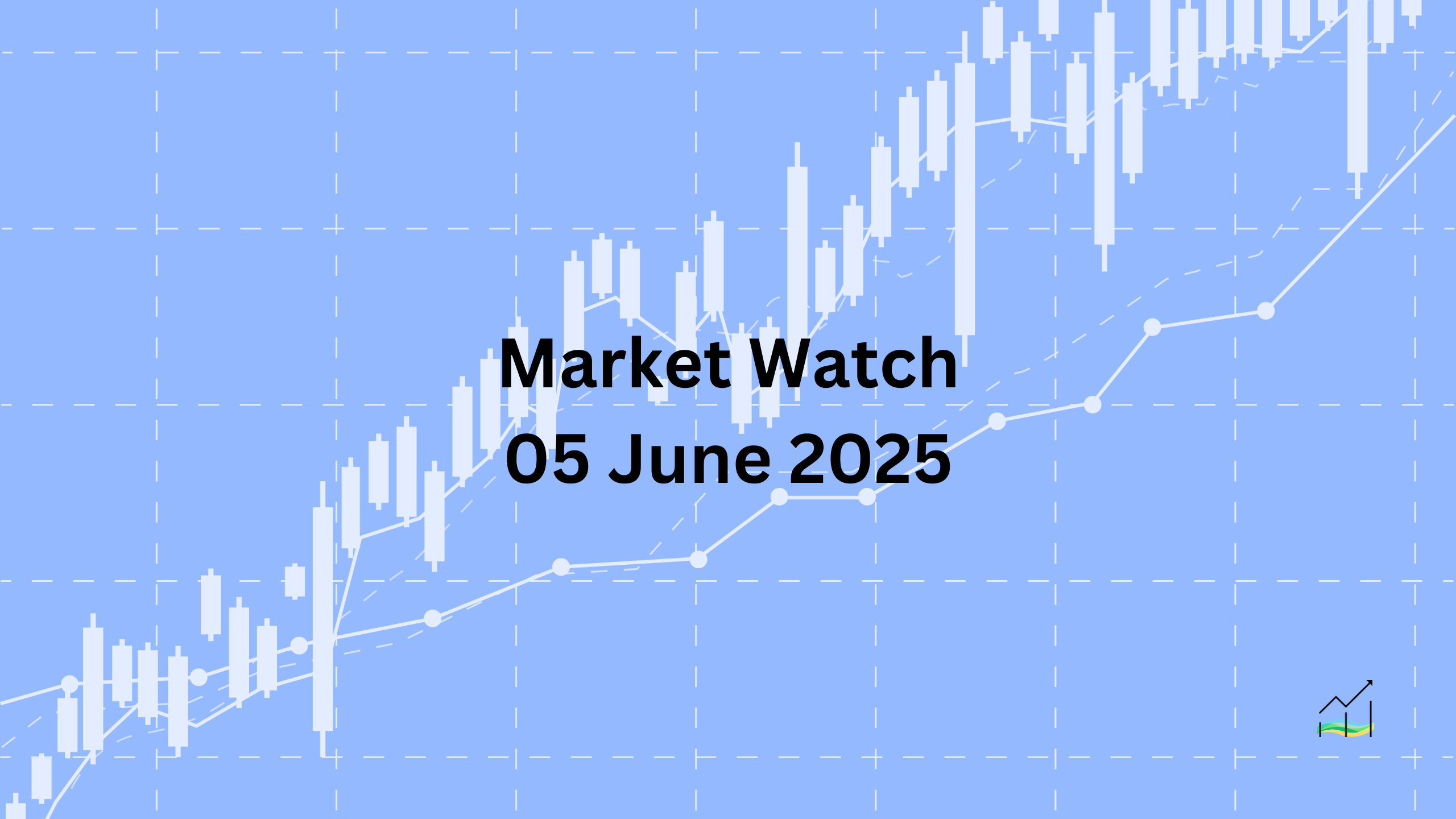05/06/2025 Market Watch

Markets Await ECB & U.S. Jobs Data as Dollar Softens, Risk Assets Rise
Key Takeaways:
- The US dollar is mostly weaker, except against the yen and Swiss franc.
- Markets are pricing in two Fed rate cuts this year, driven by weak US data.
- Emerging market currencies are generally firmer.
- ECB rate decision and US jobs report are the key events in focus.
- Global equities are broadly higher, while bond yields are declining.
- Gold remains firm; oil trades within a narrow range.
The US dollar is broadly weaker today, trading within tight ranges as markets digest a series of disappointing US data releases. Softer ADP employment figures, weaker ISM services, and a cautious Beige Book have collectively reinforced expectations of at least two interest rate cuts from the Federal Reserve this year. Despite this, the greenback has found some strength against the Japanese yen and Swiss franc, while emerging market currencies continue to gain ground. Overall, currency markets remain calm, with limited volatility ahead of major catalysts.
Attention now shifts to the European Central Bank’s meeting, where a rate cut is widely expected alongside downward revisions to the eurozone’s growth and inflation projections. Meanwhile, anticipation builds for the upcoming US nonfarm payrolls report, which could either confirm or challenge the dovish outlook priced into the bond and currency markets.
Equities are enjoying broad support. While Japan and Australia missed out on the gains seen elsewhere in Asia, European equities are rallying for a third straight day, led by the Stoxx 600. US index futures are also trading higher, underpinned by expectations of easier monetary policy. Bond markets reflect similar sentiment, with benchmark yields across Europe and the US edging lower. Notably, Japan's 10-year yield declined by nearly four basis points following a modest 30-year bond auction. Gold is steady, trading near the upper end of this week's range, while crude oil remains trapped in a narrow band below key resistance levels.
United States of America
Overview
The US dollar remained under pressure yesterday following a series of weak economic data that raised further doubts about the resilience of the American economy. The ADP private employment report came in far below expectations, accompanied by the first sub-50 ISM services reading since June 2024, signaling contraction in the sector. Additionally, the Beige Book highlighted growing concerns surrounding economic and policy uncertainty. These developments drove the Dollar Index lower during the North American session, approaching key multi-year support levels.
Meanwhile, April's goods trade deficit narrowed sharply, reflecting a collapse in imports following the prior month's tariff-driven surge. Imports plunged by nearly 20% — the largest on record — while exports rose modestly. This suggests a significant adjustment in trade dynamics. The full trade balance for April, productivity, and unit labor cost data are due today. Q1 productivity is expected to confirm a contraction, reversing the steady growth seen in 2023 and 2024. Unit labor costs, which surged in the preliminary release, will also be closely watched for revisions.
Markets are also awaiting weekly jobless claims and tomorrow’s nonfarm payrolls report. Although a slowdown in job creation is widely anticipated, the unemployment rate could be the more decisive factor in shaping rate expectations. The Atlanta Fed's GDPNow tracker will be updated today, with the last reading revised up sharply to 4.6%.
Economic Drivers
- Weak ADP private employment (37k vs. 114k expected) raised concerns about labour market resilience.
- ISM services index fell below 50, indicating contraction in the service sector for the first time since mid-2024.
- The Beige Book pointed to increased uncertainty surrounding economic conditions and monetary policy.
- April’s sharp drop in goods imports signals post-tariff adjustment in trade flows.
- Q1 productivity contracted after strong gains in 2023 and 2024, while unit labor costs rose significantly.
- Weekly jobless claims remain elevated, with potential implications for the broader employment trend.
Data and Events
- 05 June 2025: Unemployment Claims.
Price Action
- Dollar Index continued its decline, testing support near 98.60.
- Key technical level remains the 97.90–98.00 zone, marking the three-year low.
- Currently trading in a tight range below 99.00 ahead of today’s data releases.
Key Points:
- Dollar weakened further on poor ADP and ISM data.
- Beige Book flagged economic and policy uncertainty.
- Trade deficit narrowed sharply due to record import drop.
- Productivity and labour cost data may shape near-term outlook.
- Nonfarm payrolls and unemployment rate remain key focus.
Canada
Overview
The Bank of Canada maintained its current policy stance in its latest meeting, but the broader message suggests that its rate-cutting cycle is still underway. Despite the steady policy decision, the Canadian dollar strengthened, supported by broader US dollar weakness. The loonie reached its strongest level since October, driven by the shifting rate outlook and underlying economic conditions. The US dollar dropped toward CAD1.3650, and although it has stabilised for now, upside momentum appears limited.
Canada’s April trade data is due today, which will help clarify the broader trend. Despite consecutive trade deficits in February and March, a substantial surplus in January means that the first quarter closed with a modest goods surplus — a marked improvement over Q1 2024. The IVEY PMI will also be released and may provide additional insights into domestic economic momentum. The index declined in April, continuing its two-month slide and reflecting weakening activity across sectors.
Economic Drivers
- Bank of Canada held interest rates steady but is expected to continue with further easing.
- Canadian dollar strength reflects underlying USD weakness and market anticipation of policy divergence.
- A solid January trade surplus offset prior monthly deficits, leading to a modest Q1 goods trade surplus.
- IVEY PMI reflects declining economic activity, posting its second straight monthly decline in April.
Data and Events
- 05 June 2025: Ivey PMI.
Price Action
- Canadian dollar rose to its highest level since October.
- USDCAD approached 1.3650 and is holding below recent resistance at 1.3685.
- Downside technical levels include 1.3625 (Bollinger Band) and 1.3600, though support remains weak.
Key Points:
- Bank of Canada kept rates unchanged, but easing is expected to continue.
- Loonie strengthened as US dollar weakened.
- Trade balance expected to confirm a Q1 surplus.
- IVEY PMI signals continued softness in domestic activity.
China
Overview
The Chinese yuan continued to strengthen against the US dollar for the second day, as broad dollar weakness persisted across global markets. The yuan reached an eight-day high near CNH7.1700 before retracing slightly. While the currency remains within familiar levels, market attention is turning to evolving domestic and external risks. The People's Bank of China adjusted its daily reference rate lower after two consecutive increases, reflecting some willingness to allow for yuan strength amid global dollar softness.
China’s economic data remains mixed. The Caixin services PMI showed modest improvement in May, but a sharper-than-expected drop in the official manufacturing PMI pulled the composite index below the 50 threshold for the first time since late 2022. This points to renewed weakness in overall economic activity. On the external front, geopolitical tensions with the US appear to be resurfacing, particularly around trade in semiconductors and critical minerals. Container shipments to the US have declined again, highlighting trade frictions. While China is pushing forward in developing a self-sufficient chip industry, areas like rare earth processing and magnet production remain strategic strongholds not easily substituted by the US.
Economic Drivers
- Yuan strengthened as the US dollar weakened broadly across markets.
- PBOC lowered the daily reference rate, signalling more tolerance for yuan gains.
- Caixin services PMI improved modestly, but manufacturing weakness weighed on the overall composite.
- Composite PMI fell below 50, indicating renewed contraction in economic activity.
- Trade tensions with the US are escalating again, particularly in tech and critical minerals.
- China continues advancing its domestic semiconductor capabilities despite export controls.
Data and Events
- 05 June 2025: Caixin Services PMI.
Price Action
- USD/CNH fell to an eight-day low near 7.1700 before bouncing to 7.1820.
- Recent low of 7.1615 marks the weakest dollar level since November.
- Market remains within short-term consolidation range amid shifting sentiment.
Key Points:
- Yuan extended gains as dollar weakness persisted.
- Composite PMI slipped below 50, signalling economic contraction.
- Trade tensions with the US are rising over chips and critical minerals.
- China continues building self-reliance in key tech sectors.
Europe
Overview
The euro held its ground above the $1.1400 level after a firm close yesterday, supported by market expectations ahead of today’s European Central Bank decision. With option expiries clustered near this level and a lack of upward momentum, the currency remained rangebound between $1.1400 and $1.1435 in early trading. A break above $1.1455 could reopen the path toward last month’s 3.5-year high near $1.1575.
All eyes are on the ECB, which is widely expected to deliver a 25-basis-point rate cut. Recent inflation data, particularly the sub-2% reading for May, has left little room for doubt. However, the spotlight is shifting to the central bank’s updated macroeconomic projections and the tone of its forward guidance. Forecast revisions are expected to show weaker growth and lower inflation compared to the March outlook. As for future policy direction, ECB President Christine Lagarde is likely to adopt a cautious tone, avoiding firm commitments. While a July rate cut seems unlikely, the September meeting, which includes fresh projections, could be more decisive depending on evolving conditions.
Economic Drivers
- Euro remained supported by expectations of ECB policy easing.
- May CPI dropped below 2%, solidifying the case for a rate cut.
- ECB is expected to revise its growth and inflation forecasts lower.
- IMF forecasts closely align with the ECB’s medium-term outlook.
- Forward guidance is expected to be cautious, with a pause likely before any further cuts.
Data and Events
- 05 June 2025: Main Refinancing Rate.
- 05 June 2025: Monetary Policy Statement.
- 05 June 2025: ECB Press Conference.
Price Action
- Euro held above $1.1400, with resistance at $1.1435 limiting upside.
- Break above $1.1455 would re-target last month’s high near $1.1575.
- Market is consolidating ahead of ECB decision and guidance.
Key Points:
- ECB is widely expected to cut rates by 25 basis points today.
- Inflation has fallen below 2%, reinforcing the case for easing.
- Revised projections likely to show weaker growth and lower inflation.
- Lagarde expected to remain non-committal on further rate cuts.
Japan
Overview
The Japanese yen strengthened as the US dollar lost momentum following weaker US economic data and a decline in US Treasury yields. After briefly touching a three-day high near JPY144.40, the dollar reversed sharply and dropped toward the JPY142.60 level. It made a marginal new low near JPY142.50 earlier today before stabilising around JPY143.40. Despite weaker correlation with yields in recent sessions, the 10-basis-point drop in the US 10-year yield added to the downward pressure on the dollar. Support appears to be building around the JPY142.00 zone.
On the domestic front, Japan’s nominal labour cash earnings were stable in April, rising 2.3% year-over-year — an improvement over the 1.6% recorded in the same period last year. However, inflation continues to erode real wages, which declined by 1.8% compared to a 1.2% drop in April 2024. This persistent decline in real income is likely weighing on household consumption. Household spending data due tomorrow is expected to reflect this drag, with growth projected to slow to 1.5% from March’s 2.1%.
Economic Drivers
- Yen appreciated as soft US data and falling Treasury yields pressured the dollar.
- Labour cash earnings rose 2.3% year-over-year in April, continuing nominal wage gains.
- Real cash earnings fell 1.8% year-over-year due to inflationary pressures.
- Persistent decline in real income likely to dampen household spending.
- Consumption outlook remains weak heading into upcoming data.
Data and Events
- 05 June 2025: 30-y Bond Auction.
Price Action
- Dollar rose to JPY144.40 before retreating to JPY142.50.
- Support remains around the JPY142.00 level.
- Recovered modestly to JPY143.40 in today’s session.
Key Points:
- Yen gained as weaker US data dragged down yields and dollar strength.
- Real wages remain negative despite steady nominal income growth.
- Household spending expected to slow due to erosion in real earnings.
- Technical support seen around JPY142.00.
© 2025 SKONE Enterprise (003319453-V). All rights reserved.
The content on this site is for informational purposes only and does not constitute financial advice.


